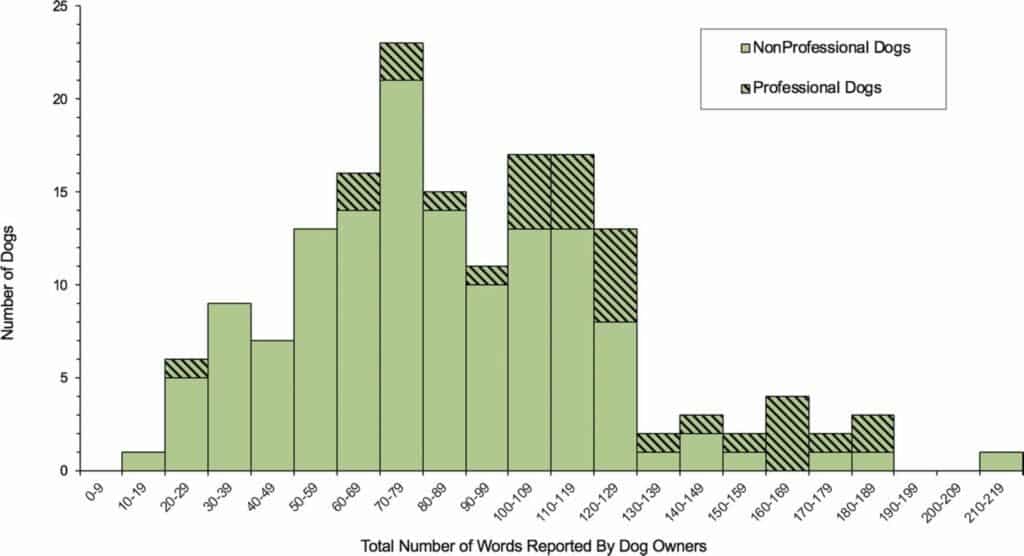
By several behavioral measures, the mental abilities of the average canine are on par with those of a human child around age two. They’re also very similar in their comprehension of words, with a new study finding that, on average, dogs respond to 89 words.
“We aimed to develop a comprehensive owner-reported inventory of words to which owners believe their dogs respond differentially and consistently,” wrote Catherine Reeve and Sophie Jacques, the authors of the new study, both researchers at Dalhousie University, Canada.
How many words do dogs know?
Dogs, which are likely the first domesticated animals, and humans share a strong bond that stretches back thousands of years. Over time, dogs were selected for traits that made them more sociable, loyal, and cooperative.
Early on, domesticated canines proved useful in hunting, but nowadays they occupy a wide range of specialized roles, such as search and rescue, agriculture, police, and scent detection (dogs can sense several types of cancer, migraines, low blood sugar, seizures, diabetes, and even COVID-19).
Their ability to fulfill these roles hinges, for the most part, on their responsiveness to human social cues. Often these cues are verbal commands and basic utterances during various contexts (i.e. playtime or walking), but also non-verbal cues such as gestures.
As early as the 1920s, scientists have sought to assess dogs’ ability to comprehend human speech. One study from 1928 documented the ability of Fellow, a young male German Shepherd, to respond to verbal commands uttered by his owner. Fellow could recognize 68 words and phrases, including phrases such as “Go outside and wait for me“.
More recently, a 2004 study found that Rico, a Border Collie, could identify and retrieve over 200 items, such as various different balls and stuffed toys, when the owner uttered each item’s unique name.
These studies show that dogs can respond consistently and differently to spoken words and phrases, something not at all surprising even to first-time dog owners. But the Canadian researchers wanted to investigate more closely and empirically the extent to which typical dogs respond to words. Fellow, Rico, and most other canines involved in similar studies were very well trained, for instance.

Not all dogs are equally responsive
In order to quantify the number of words a dog could comprehend, the researchers employed virtually the same tool that psychologists use to assess infants’ understanding and development of early language, based on a parent-reported checklist called the MacArthur-Bates Communicative Development Inventory.
A total of 165 owners of a variety of dog breeds were surveyed about the different words and phrases that their pets seemed to understand. Each owner was also asked questions about themselves that were relevant to the study, such as dog training experience and household member composition, as well as about their dogs (i.e. breed, age, sex, training background).
On average, dog owners identified 89 terms that their pets responded to consistently, half of which were classed as commands. There were outliers, of course, with one clever dog reported to respond to 215 words. The least responsive dog responded to only 15 words.
The most responsive breeds included the Australian Shepherd, Border Collie, German Shepherd, Bichon Frise, Cavalier King Charles Spaniel, and Chihuahua. Breeds that were not quite as responsive included hounds like the Beagle and Whippet or working-guardians like Boxers and the Cane Corso.
The most common words dogs responded to were their own name, as well as command-like words like ‘sit’, ‘come’, ‘down’, ‘stay’, ‘wait’, ‘no’, ‘OK’ and ‘leave it’. But many dogs could also understand nouns like ‘treat’, ‘breakfast’, ‘dinner’, ‘garbage’, ‘poo’ and things to chase, such as a ‘ball’ or ‘squirrel’.
A word was counted as a response if the pet looked up, whined, ran, wagged their tails, or performed a requested action.

“The current study takes an important first step towards developing an instrument that makes it possible to identify which words might most likely be responded to by dogs. Although research on dogs’ responses to words exists, much of it has been limited in scope (e.g., teaching a handful of commands or object words) or sample size (e.g., training a single dog). The current study is consistent with existing research suggesting that dogs may be particularly adept at responding to commands rather than object words,” the researchers wrote in their study published in the journal Applied Animal Behaviour Science.
The researchers cautioned, however, that these results do not prove that dogs actually understand the meaning of the words. They could respond to various words uttered by humans due to operant or classical conditioning, i.e. basic dog training. The sounds that form the word ‘sit’ are eventually associated with a reward. But that doesn’t mean that dogs can actually process the meaning of the word linguistically in the same way humans can.
Dogs may also learn to associate certain sounds that form words with events or objects more passively by learning the association between them through repeated pairings, a process scientists call statistical learning.
“With additional research, our tool could become an efficient, effective, and economical research instrument for mapping out some of their competences and perhaps help predict early the potential of individual dogs for various professions,” they added.






